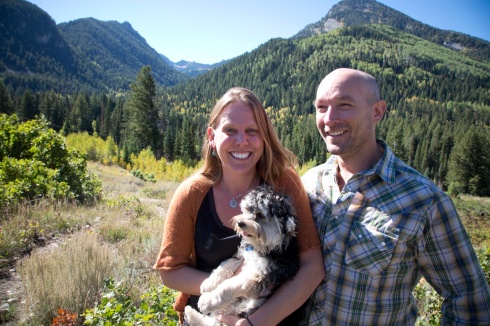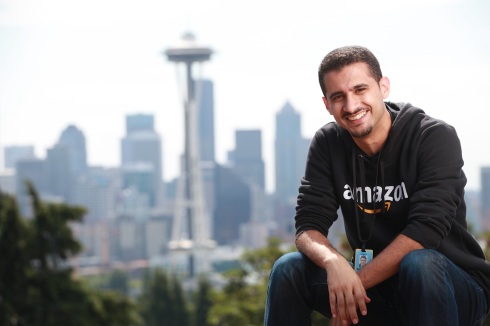
Finding alumni to feature has been one of my favorite parts of the whole VISIONS Across America project.
Case in point: Many months ago, I was searching the alumni database for unique stories to tell in Utah. When I found Kathie Taylor and Rob Andress, a couple in Salt Lake City, Jim and I got really excited. My research showed that Kathie was a wildlife biologist and ecological consultant and that Rob was a hydrogeologist. Wow – a double whammy in one of the most beautiful states in the country.
“Finding” them turned out to be a two-part process. Kathie quickly returned my email, and we scheduled a morning meeting (with breakfast!) at their home in late September. But the directions she sent to their home left us a little confused once we were actually in the car and trying to drive there.
“Take the 6200 South exit from I-215,” her directions began. “Follow the signs for Big Cottonwood Canyon. From the mouth of the canyon, we are 8.2 miles up and across a creek. We don’t have a ‘real’ address, so it’s a bit tricky to find. Call me and I’ll be at the road to meet you.”
It turns out that I had to call more than once, because Jim and I were never really sure we were going the right way or were even in the right canyon. But Kathie assured us that we couldn’t get lost, and she gave us a landmark to watch for: big green Dumpsters. We drove up and up and up.
Happily, we found her.
She opened the gate that led us up a private road to a cabin, one of about 25 homes on the mountain. We were greeted by Rob, who had started a fire in the wood stove, and by a small, enthusiastic dog named Crawford. The cabin smelled fantastic – like wood and coffee and something delicious baking in the oven.

While breakfast was cooking, Rob and Kathie gave us a tour of the two-story cabin they’ve lived in since 2001. The bedroom is downstairs; kitchen, living room, and office space (above) is on the main floor. The cabin is small, cozy, and efficient.
Rob and Kathie are one of a handful of homeowners in their neighborhood that live there year-round. The rest are summer homes.
At 7,400 feet, winter comes early here, and the Wasatch Mountains get a lot of snowfall – three feet in three days once – but Kathie is unfazed. She grew up in northwest Ontario, Canada, the daughter of parents who ran a fishing camp.
“My dad gave me the genes to be on the path I’m on,” Kathie says.
She was “destined” to go to Iowa State, too. Her father, a Creston native, attended Iowa State, as did her sister and some cousins.
Kathie was an undergraduate when she met Rob, a grad student. Kathie was doing fieldwork on a forestry project and Rob was writing his thesis. They met through mutual friends.
Following graduation in 1999 – Kathie with a bachelor’s degree in animal ecology and Rob with a master’s in geology and water resources – Rob began to apply for jobs in Utah.
Kathie wasn’t so sure about that.
“I thought, ‘UTAH? They don’t even serve real beer in Utah!’”
She’s since become a convert.
“Salt Lake City is a hub for lots of things around it. There’s lots of things to do, recreation-wise,” she says. “There are a lot of out-of-the-way places – probably 50 places for every national park and other areas you’ve heard of.”
The couple climb, hike, bike, camp, ski, river raft, and backpack. High-end ski resorts are located within a couple of miles of their cabin.
Rob owns his own hydrogeology firm, Gradient LLC. Kathie owns an ecological consultant company called Argenta Ecological. They share an office in the cabin, but for weeks and even months at a time they’re on the road, working for federal agencies (U.S. Fish and Wildlife Service, Bureau of Reclamation, etc.) and with non-profits.
“We call ourselves ‘conservation gypsies,’” Kathie says.
Rob explains that they bid jobs separately but try to team up to do the work, often traveling to Nevada and Arizona. Much of the work has been in the area of habitat restoration for endangered desert fishes and invertebrates.
After breakfast and a brisk walk to the top of the mountain (see photo at top), Rob and Jim climbed into our rental car and Kathie and I followed in her truck. Our destination was the Provo River in the Heber Valley, south of Salt Lake City.
With Kathie in the driver’s seat and Crawford on my lap, we went up and over the mountains, past the ski resorts and through a landscape Kathie calls “an island in a sea of desert.”
We arrived at the Provo River and began to scout for photo-shoot locations. Kathie explained that she did one of her first jobs in this area – tagging Columbia spotted frogs. (“Such a great job! I used to come here every day and catch frogs,” she said.)

She had no qualms about wading waist-deep into a wetland adjacent to the river, fully dressed. Rob held Jim’s portrait light so it didn’t fall in the water, and I held on to the dog. We attracted a lot of attention. Afterwards, Jim photographed Rob watching birds, a slightly drier pursuit.

During my research phase I had learned that Kathie and Rob both do site assessment and design, and Rob does construction oversight, restoring springs and their outflow channels. Kathie also conducts wildlife surveys but has “morphed into a bit of a GIS Jack-of-all-trades.” (“I make a lot of maps and do spatial analysis for listed/sensitive species and for threatened landscapes,” she explained in an email.) They also do some writing – technical reports and management recommendations mostly – and at the time of our visit Kathie was in the final stages of writing a book about a place in Nevada called Ash Meadows that has a very high rate of endemic fish, plants, and insects. It’s also a place where Rob has done restoration work.
Spending the day with Kathie and Rob – seeing where they live and visiting one of the places they’ve actually worked – just reinforced the coolness of my job (meeting awesome people in awesome places) and the truly amazing variety of lives being led by Iowa State alumni. I mean, seriously, here we are in a pond in Utah. I could not have imagined this when we started this project.

So when we’re finished with the photo shoot and Kathie is covered up to her waist with pond “detritus” (and no spare clothes to change into), she suggests that we all go out for a late lunch at this Latin American restaurant nearby.
Really?
“It’s OK,” she laughed. “They have a patio.”
We spent the next hour on a sun-warmed deck somewhere near Provo, Utah, eating our combined weight in salsa.
And wouldn’t you know it? The next day it snowed.







